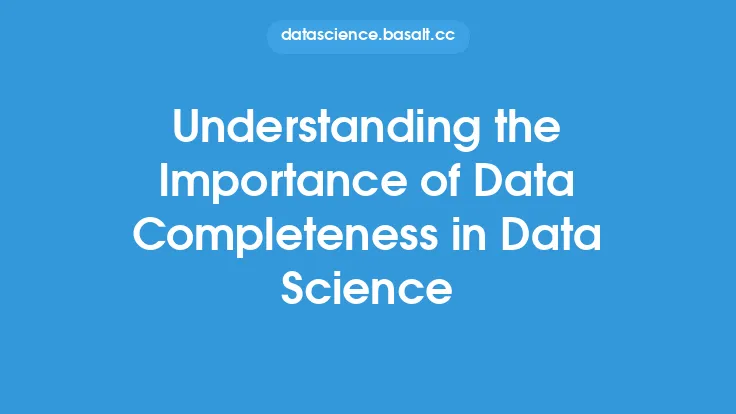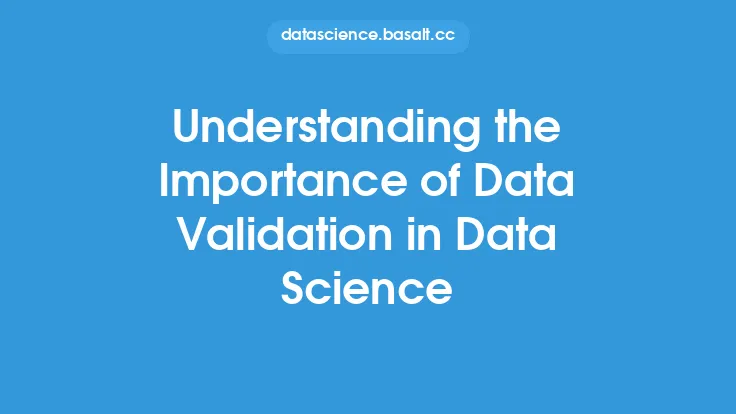Data normalization is a crucial step in the data science process, playing a vital role in ensuring the quality and reliability of data. It is a process of organizing and structuring data in a way that makes it more efficient and effective to analyze. Normalization involves transforming raw data into a standardized format, which helps to reduce data redundancy, improve data integrity, and enhance data scalability. In this article, we will delve into the importance of data normalization in data science, exploring its benefits, techniques, and best practices.
Introduction to Data Normalization
Data normalization is a fundamental concept in data science, and it is essential to understand its significance in the data processing pipeline. Normalization helps to eliminate data inconsistencies, reduce errors, and improve data quality. It involves applying a set of rules and techniques to transform raw data into a standardized format, making it easier to analyze and process. Data normalization is a critical step in data preprocessing, and it is essential to apply normalization techniques to ensure that data is accurate, complete, and consistent.
Benefits of Data Normalization
Data normalization offers several benefits, including improved data quality, reduced data redundancy, and enhanced data scalability. Normalization helps to eliminate data inconsistencies, reduce errors, and improve data integrity. It also enables data to be shared and integrated across different systems and applications, making it easier to analyze and process. Additionally, normalization improves data security by reducing the risk of data breaches and cyber attacks. By applying normalization techniques, data scientists can ensure that data is accurate, complete, and consistent, which is essential for making informed decisions.
Types of Data Normalization
There are several types of data normalization techniques, including entity normalization, referential normalization, and data type normalization. Entity normalization involves transforming data into a standardized format, eliminating data redundancy and improving data integrity. Referential normalization involves establishing relationships between different data entities, ensuring that data is consistent and accurate. Data type normalization involves transforming data into a specific data type, such as integer or string, to ensure that data is consistent and accurate.
Data Normalization Techniques
Several data normalization techniques are used in data science, including min-max scaling, z-score normalization, and logarithmic normalization. Min-max scaling involves transforming data into a specific range, usually between 0 and 1, to reduce the impact of extreme values. Z-score normalization involves transforming data into a standard normal distribution, with a mean of 0 and a standard deviation of 1. Logarithmic normalization involves transforming data into a logarithmic scale, reducing the impact of extreme values and improving data interpretability.
Data Normalization in Data Warehousing
Data normalization is a critical step in data warehousing, ensuring that data is organized and structured in a way that makes it efficient and effective to analyze. Data warehousing involves integrating data from different sources, and normalization helps to eliminate data inconsistencies and improve data quality. Normalization also enables data to be shared and integrated across different systems and applications, making it easier to analyze and process. By applying normalization techniques, data scientists can ensure that data is accurate, complete, and consistent, which is essential for making informed decisions.
Data Normalization in Big Data
Data normalization is also essential in big data, where large volumes of data are processed and analyzed. Big data involves processing large amounts of unstructured and structured data, and normalization helps to eliminate data inconsistencies and improve data quality. Normalization also enables data to be shared and integrated across different systems and applications, making it easier to analyze and process. By applying normalization techniques, data scientists can ensure that data is accurate, complete, and consistent, which is essential for making informed decisions.
Best Practices for Data Normalization
Several best practices are essential for data normalization, including understanding the data, applying normalization techniques, and validating data quality. Understanding the data involves knowing the data source, data format, and data quality, which is essential for applying normalization techniques. Applying normalization techniques involves using techniques such as min-max scaling, z-score normalization, and logarithmic normalization to transform data into a standardized format. Validating data quality involves checking data for errors, inconsistencies, and inaccuracies, which is essential for ensuring that data is accurate, complete, and consistent.
Conclusion
Data normalization is a critical step in the data science process, playing a vital role in ensuring the quality and reliability of data. It involves transforming raw data into a standardized format, eliminating data inconsistencies, and improving data integrity. By applying normalization techniques, data scientists can ensure that data is accurate, complete, and consistent, which is essential for making informed decisions. Understanding the importance of data normalization is essential for data scientists, and applying best practices can help to ensure that data is of high quality and reliable.





